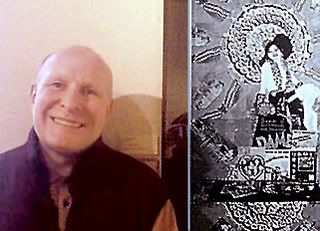Wildlife: The families of Redheaded Ducks are showing their patterned plumage as their ducklings grow larger. The similar Canvasback Ducks have red heads too, but plain, white bodies below their necks.

Visit: A Tale of Two MoviesWeather: Saturday started out sporting mostly-sunny skies, but when rain clouds rolled overhead, they poured out streams of water.
Charity Alert:
The Animal Rescue Site Goal: 2.7 million bowls of food this month -- help them with another click please.
Garage Sale Booty: We bought a used computer desk and a new front door, transporting them separately in the Honda CV. We also got a copy of U2's first album
October on cassette tape for twenty-five cents.
Media Watch; There was a surprise for me on CSPAN -- Betsy Burton was in New York City at "Book Expo America" on June 3, 2005, speaking about her book
The King's English -- which happens to be the name of the small, independent bookstore she owns, located at Fifteenth East and Fifteenth South in Salt Lake City -- one of my regular stopping points whenever I needed a shot of culture there.
Her story was about the efforts required to maintain a shop such as hers against the massive intrusion of chain stores and Amazon-Dot-Con on our economy. She spoke about "passion" quite often, and likened her passion for books, reading, authors, and human-scale stores with "the environment," which was an extraordinarily correct analogy. She spoke about how mega-chains drained communities, and how those economic statistics won much-needed support from local politicans in pitched battles between living communities and vacuous strip malls.
Her "King's English" bookstore specializes in poetry and modern literature. While I like and admire these things, my tastes run more towards popular, and even "pulp" culture. I regularly visited Smokey's Records next door, and even took in artwork to the far-corner gallery for framing. While I was there, I patronized Einstein Brothers Bagels across the street too, where I often said HI! to Robert Kleinschmidt, my printmaking instructor from the nearby University of Utah, who hung out in that busy place. I usually only visited the "King's English" for autographed first editions, just ahead of, or right after, a visiting author's visit. For some reason or another, I rarely attended their plentiful readings and receptions.
MY favorite "cultural village" in Salt Lake was centered at the corner of Ninth East and Ninth South -- A.K.A. the 9th & 9th. Salt City CDs had Bill Laswell, George Clinton, and Bootsy Collins' Parliament/Funkadelic classics right on their shelves. The Tower Theater showed movies like
Plan 10 From Outer Space,
SLC Punk,
Orgasmo, and
Rocky Horror. There were herbal shops, import stores, a do-it-youself ceramic studio, a quality veggie restaurant, a bakery, a mainstream supermarket, plus the best espresso bar in the Western USA -- the Coffee Garden. Creative people congregated there for many reasons, and it was a fine place to either run errands, hear about new happenings, or enjoy the sights and sounds around you, just as they were.
There were other energetic spots around town -- I liked Greywhale CD's near the University, and the bargain book stores, but I felt uncomfortable around the piecing parlors, fortune-telling booths, and soft-core porn stalls of Sugarhouse, so I rarely stopped off to go to the import stores there, and only if I wanted an unusual gift.
I will mention two other places of interest to me in Salt Lake -- Ken Sanders' Used Books was always good for browsing and conversations. I met the poet Alex Caldiero in Ken's shop, for instance. Kilby Court Gallery was actually a house with a sprawling backyard shop in a rundown industrial slum area near downtown, but I saw some dynamic theater performed there -- including Alex, who is always performing his poems in unusual ways and places.

